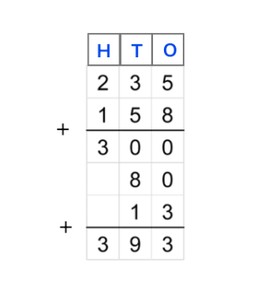
Partial sums addition to 1,000 with regrouping
Students learn partial sums addition to 1,000.



8,000 schools use Gynzy
92,000 teachers use Gynzy
1,600,000 students use Gynzy
General
Students learn partial sums addition to 1,000 with regrouping.
Standards
CCSS.Math.Content.2.NBT.B.7
CCSS.Math.Content.3.NBT.A.2
Learning objective
Students will be able to add partial sums to 1,000 with regrouping of the tens and hundreds number.
Introduction
You have the students add to 1,000 in groups. To do this they add either 50 or 100. The first student starts with a hundreds number or a fifties number and states whether 50 or 100 must be added to it. The next states the answer and then says how much should be added to that number. They keep calculating until they reach 1,000. Then you show two answers on the interactive whiteboard. The students must determine which of the two numbers form the answer together. Drag the numbers to the right place.
Instruction
Explain that to add using partial sums, you put the numbers one under another. Then you can add them together by solving from left to right. State that you put the largest number of the sum on the top and the other number underneath it. For partial sums, you work from left to right. So you start with adding the hundreds numbers together. Then you calculate how much the tens numbers are together and then you add the ones values together. In adding the ones numbers up, it can happen that you go into the tens values. In that case you write the number in the tens number space and the ones value space. You put all these numbers in the diagram and you state what the intermediate sums were. If you add the numbers from the diagram together, then you find the answer. You put this answer at the bottom. Next there are two sums in diagrams, in which different rows are in yellow. Ask the students if they know which intermediate sum belongs in each colored row. This is how you can check whether students know which steps they have to take. Then you have the students solve a few problems with partial sums. Next you explain that you can also add above the hundreds numbers. In that case you write the number in the spaces for the hundreds numbers, the tens numbers and the ones values. Then practice partial sums in two problems for which for one, part of the diagram is already filled in and for the other, the diagram still must be filled in.
Check whether the students can add using partial sums using the following questions/exercise:
- Why is it useful to be able to add using partial sums?
- What do the letters H T O mean?
- In solving partial sums, where do you always start?
- Calculate these using partial sums: 436 + 66 and 287 + 162 + 131
Quiz
The students are given ten questions in which they first practice partial sums by stating what the intermediate steps are. Then they solve a few problems using partial sums. These sums consist of two or three numbers that the students must add together.
Closing
You discuss again with the students that it is important to be able to solve partial sums to 1,000, because that is how you can solve problems in steps. Check whether the students know that for partial sums they must solve from left to right and when they go over a tens number or a hundreds number, they also must add this number to the diagram. Have the students practice partial sums addition in pairs. They both write a number and must figure out how they solve this together using partial sums. First they practice this with two numbers. Also have the students practice using a sum with three numbers.
Teaching tips
For students that have difficulty with partial sums addition, you can remind them of the meaning of H T O and how you put the numbers into an HTO-diagram. Write out the intermediate sums. You can label the hundreds numbers, tens numbers and ones values, so that it is more obvious what you are adding together.
The online teaching platform for interactive whiteboards and displays in schools
Save time building lessons
Manage the classroom more efficiently
Increase student engagement
Discover more!
About Gynzy
Gynzy is an online teaching platform for interactive whiteboards and displays in schools.
With a focus on elementary education, Gynzy’s Whiteboard, digital tools, and activities make it easy for teachers to save time building lessons, increase student engagement, and make classroom management more efficient.



